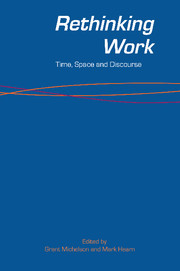Book contents
- Frontmatter
- Contents
- Tables and Figure
- Contributors
- Editorial Statement
- Abbreviations
- 1 Going to a New Place
- PART I TIME
- 2 Time and Work
- 3 The Gender Agenda
- 4 Regulation and Deregulation in Australian Labour Law
- 5 Diversity and Change in Work and Employment Relations
- 6 Transactions in Time
- PART II SPACE
- PART III DISCOURSE
- COMMENTARY
- Index
4 - Regulation and Deregulation in Australian Labour Law
Through a Reflexive Lens
Published online by Cambridge University Press: 05 June 2012
- Frontmatter
- Contents
- Tables and Figure
- Contributors
- Editorial Statement
- Abbreviations
- 1 Going to a New Place
- PART I TIME
- 2 Time and Work
- 3 The Gender Agenda
- 4 Regulation and Deregulation in Australian Labour Law
- 5 Diversity and Change in Work and Employment Relations
- 6 Transactions in Time
- PART II SPACE
- PART III DISCOURSE
- COMMENTARY
- Index
Summary
Theory is about explaining the present and predicting the future. In a period of what may prove to be epochal change in Australian labour law, I shall argue in this chapter that students of labour law need some extra tools to enable them to make sense of what is happening and to analyse these changes in some kind of coherent historical continuum. This might prove to be problematical as Australian legal writers have never shown a great deal of interest in theory, although as will be shown below, some labour law writers are beginning to use overtly theoretical frameworks to explain and to influence political opinion, and other writers are using regulation theory to analyse events. In an era when regulation and deregulation are contentious topics for academics, policy-makers and practitioners, however, a lack of interest in theory continues to dominate. But this is not to suggest that most labour law writers are what the undergraduate jurisprudence textbook writers would describe as ‘black letter enthusiasts’ or even that their writing is without a frame of reference. Interestingly, significant writing exists in the area of feminist and feminist-inspired Australasian labour law writing (for example Bennett 1988; Hunter 1992; Owens 1993; Wilson 1994; MacDermott 1996). Just why Australian (and New Zealand) writers have taken up feminist theory with such apparent gusto but not other kinds of theory is beyond the scope of this chapter.
- Type
- Chapter
- Information
- Rethinking WorkTime, Space and Discourse, pp. 60 - 78Publisher: Cambridge University PressPrint publication year: 2006



